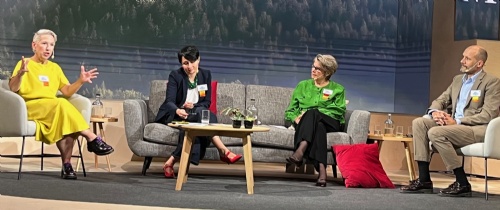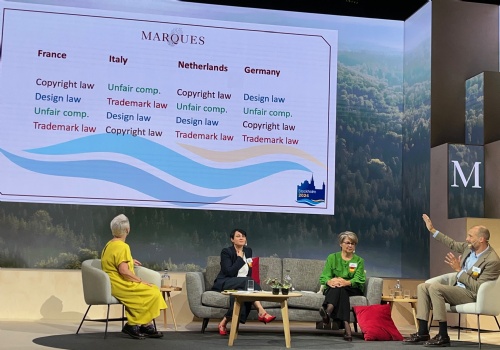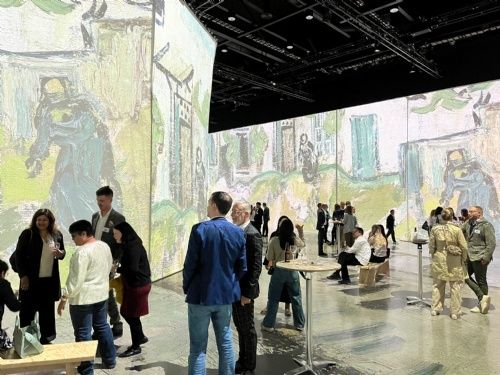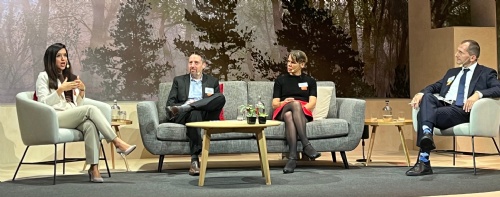Now in its twelfth year, Class 46 is dedicated to European trade mark law and practice. This weblog is written by a team of enthusiasts who want to spread the word and share their thoughts with others.
Click here subscribe for free.
Who we all are...
MARQUES Annual Conference 2024, Stockholm – parts 3 and 4
 |
| Catrin Turner, Noemi Parrotta, Sarah Bailey and Jesse Hofhuis |
Attention turned to how to protect product designs and how consumers understand lookalikes at the MARQUES Annual Conference on Wednesday afternoon.
In part 3 of the programme, “You can understand local traditions in the protection of product design”, Jesse Hofhuis, AC&R, The Netherlands, a member of the MARQUES Programming Team, moderated a panel that compared the protection available for product designs in EU countries, looking at trade marks, designs, copyright and unfair competition.
During the session, panellist Catrin Turner, Airwair International Ltd, UK, described the Dr. Martens enforcement strategy and her role: “My job is to preserve the authenticity the history and the craftsmanship of our products.” She explained how she does this based on five principles: keep copies away from customers; chaos and complexity are your friends; work with the best and spend whatever you need to win; enforcement is global; and nice is banned.
She explained how these influence decisions including which rights to enforce, which jurisdictions to choose and which remedies to seek. “A lot of work we do is done informally. A lot of infringers are family-owned,” said Catrin, who accompanied her presentation with pictures of genuine Dr. Martens footwear and copies. But she added: “When it comes to litigation, nice is banned. Pace is really important. Don’t ask any favours. This goes against the grain for a lot of lawyers. “
 Noemi Parrotta, Spheriens, Italy, a member of the MARQUES Famous & Well Known Marks Team provided an Italian perspective while Sarah Bailey, Simmons & Simmons, France, a member of the MARQUES Council and Regulatory Team, discussed product design protection in France and moderator Jesse summarised the Dutch position. They all placed the various IP rights in a hierarchy (see picture) which illustrated the inconsistency in Europe.
Noemi Parrotta, Spheriens, Italy, a member of the MARQUES Famous & Well Known Marks Team provided an Italian perspective while Sarah Bailey, Simmons & Simmons, France, a member of the MARQUES Council and Regulatory Team, discussed product design protection in France and moderator Jesse summarised the Dutch position. They all placed the various IP rights in a hierarchy (see picture) which illustrated the inconsistency in Europe.
“Designs are good but drawbacks include uncertainty and very limited scope of protection,” said Noemi. She added: “Trade marks ideally are the most powerful tool for protection but absolute bars and lack of distinctiveness are challenges.” It is hard to prove acquired distinctiveness at the EU level, she said, but “it may be easier at a national level.”
She illustrated her presentation with cases involving the Vespa scooter, Tic Tac sweets, Moon boot and other products.
In France, said Sarah, “copyright is an easy right to rely on” compared to trade marks or designs, but she would normally recommend supplementing it with an unfair/parasitic competition claim.
Diverse views on consumer behaviour
 |
| MARQUES Cultural Evening at Artipelag |
In part 4 of the conference, “You can navigate consumer values”, a panel of speakers with diverse expertise discussed how to understand consumers’ attitude to lookalikes. The panel was chaired by Michael Noth, Times Attorneys, Switzerland, Chair of the MARQUES Famous & Well Known Marks Team.
Prof. Dr. Alexander Genevsky, Rotterdam School of Management, Erasmus University, The Netherlands, provided a perspective from neuroscience. “Everything we feel and do is experienced and can be measured in the brain,” he said.
He brought an interdisciplinary perspective from economics, psychology and neuroscience and argued that brain-based methods of analysis will not replace but complement existing methods.
Alexander focused on the four Ps of neuroscience – preferences, process, prediction and perception – and shared examples of experiments, surveys and even a video of a brain being cut open. “Imagine brands as physical objects. You can observe and test the object but you need to understand its inner workings. Consumer neuroscience gives us insight into those inner workings,” he said.
 |
| Nigar Kirimova, Alexander Genevsky, Femke van Horen and Michael Noth |
Femke van Horen, Professor of Consumer Behaviour, Vrije Universiteit, The Netherlands, discussed how consumers perceive copycat products and degrees of similarity. She argued that counter-intuitively a strong activation of the imitated brand will decrease copycat evaluation but a more subtle activation will be more successful, saying: “More subtle types of similarity are likely to freeride more effectively on the brand. “
She also shared evidence that imitation based on theme is more powerful than imitation based on features.
Finally, she shared the lessons from a new neuroscientific tool based on MRI scans, which can measure similarity in a more objective way and show when a survey is biased. In conclusion, she asked: Should the focus be on blatant similarity? Should only strong and distinctive marks receive protection? How should trade mark similarity be measured?
The final speaker, Nigar Kirimova, Essity GmbH, Germany, a member of the MARQUES Famous & Well Known Marks Team, asked: Which values are important for consumers? And what types of communication and branding are attractive to them?
 |
| Femke van Horen |
She pointed out that for many consumers to day, brand values are not just about origin but include sustainability, innovation, convenience and lifestyle/aura. For FMCG products, which are bought quickly and frequently, all this has to be conveyed by the packaging.
Using the example of one of her own brands (Tempo tissues), Nigar illustrated how a brand engages with consumers by promoting kindness and “our soft side”. The challenge is to create a brand identity and purpose with a unique story that aligns with consumers’ values and stays relevant through innovation.
The question is: how to do this? Nigar said it is important to protect as many elements as possible of the packaging, avoid dilution and take advantage of unfair competition law where available. “Consumers care about more than just origin. They want to be part of the aura and image of the brand,” she said.
In the discussion after the presentations, the panel looked at whether trade mark reform is needed and if so what form it should take.
Posted by: Blog Administrator @ 06.14Tags: Annual Conference, Stockholm,


 Sharing on Social Media? Use the link below...
Sharing on Social Media? Use the link below...Perm-A-Link: https://www.marques.org/blogs/class46?XID=BHA5296

